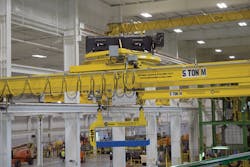The first electric overhead crane was invented in 1876 to lift large weapons at a gun factory in England. While the design concept of the crane has remained fundamentally the same, the crane has evolved with technological advances that make it stronger, faster and easier to use. Today, the overhead crane is an essential tool for the manufacturing and transport of large and heavy parts used in the automotive, construction and steel industries, among others (Figure 1).
Figure 1: This Cincinnati Crane & Hoist overhead crane uses technological advances to make it stronger and to move large, heavy parts faster and easier than ever.
(Source: Cincinnati Crane & Hoist)
With so many cranes in the market, a customer may see all cranes as identical, which opens the door to sales based solely on price. To stand out in a crowded industry, OEMs are challenged to add unique value-added features that give customers a reason to take notice.
Overhead background
In 2008, as owner of Cincinnati Crane & Hoist in Harrison, Ohio, I decided to make cranes with a different philosophy than other crane manufacturers. With a background in construction management and an eye for design, I saw the opportunity to serve companies with complex lifting needs that required extra design consideration to achieve the right crane solution. Customers have reacted positively to this approach, and as a result, Cincinnati Crane & Hoist is one of the fastest growing crane companies in America.
When we go into a company, we don’t just sell them a crane solution off the shelf. We look at the entire factory floor to see how cranes can improve and integrate multiple aspects of the operation, and we consider that company’s growth to anticipate future needs. We design the crane that will deliver the best results today and tomorrow, and that often requires looking for ways to be innovative and go beyond the typical setup.
To avoid the assumption that it sells just another commodity product, Cincinnati Crane & Hoist is always looking for ways to differentiate itself in the marketplace by adopting cutting-edge technology that adds value and unique benefits for our customers.
A better crane experience
While continuing to develop new offerings to support current and future crane operator needs, Cincinnati Crane & Hoist identified a new ergonomic, wireless remote that would have a huge impact on operator productivity and workplace safety. As the first crane manufacturer to offer this technology, we have a significant competitive edge.
In seeking an innovative new addition to our offering, we chose the Harmony eXLhoist wireless remote controller from Schneider Electric. The eXLhoist remote has the industry’s longest battery life, a quick charging time of just 15 minutes and an ergonomic design that allows for one-hand operation (Figure 2).
We believe the Schneider Electric brand and the remote is a differentiator for us. It’s a brand that our customers value, and Schneider Electric product designers are always thinking about how to update and adapt in anticipation of future customer needs.
Today’s younger work force was raised on gaming, so they are most comfortable with a gaming-style control in the workplace. They don’t want a standard square remote with pushbuttons. They want something comfortable and intuitive, and that is the real appeal of the eXLhoist remote. When customers first hold the remote, they feel the difference and want it immediately.
The old-style remotes seem dated and feel clumsy your hand. It feels feel like something from a previous century, and the eXLhoist is smooth and modern. The buttons operate easily and without the need to look at the box to choose a directional button.
Risk mitigation is important to all companies, and industrial accidents can be devastating. To prevent collisions and other dangerous situations, the eXLhoist has an intuitive interface and single-hand, pistol-grip control, so operators don’t need to look down at the remote and instead can keep their eyes on the load. With one hand free to signal crew members and the ability to monitor the load during the entire process, operators are better able to control the load leading to a safer environment.
Crane operation
The remote enables intuitive operation of the crane. There is no need to look at the remote during operation. The pistol grip that the operator holds is unique, and the motion button is thumb engaged. This eliminates the need to use two hands to operate the remote. It also eliminates the need to look away from the load that the crane is moving. Additionally, the trigger controls the speed of the hoist, which makes for safer pick and delivery of the load.
The remote communicates to the crane controller through Bluetooth technology. The controller has two safety relay outputs and an external antenna extending wireless operating distance to a large area of control. It accepts multiple voltages and has up to 18 inputs that can be adapted for use with a variety of devices and not just for use with a crane.
Safety features are built in to the remote related to communication and control. The remote cannot engage with more than one base station at a time; therefore, no other crane operator can access the control. Another feature is the ability to wire the crane safety limit switches to the base unit. The switches are then monitored to signal the operator when they are near the safety zone.
A variety of information is displayed on the eXLhoist remote. The display can present the weight of the load being picked ensuring the user is inside the lift's load limits. It shows which crane the remote is operating, Crane 1 or Crane 2, or if it’s in a tandem pick situation. The display also shows when an accessory or a below-the-hook device is attached and also has a wind indicator detecting movement.
The ergonomic, intuitive design also increases productivity. In Cincinnati Crane & Hoist’s own plant, where operators use the eXLhoist remote, it’s common to move 65,000-lb beams that are half the size of a football field and need to be turned 180°. Watching the load, instead of looking down at buttons on a standard control station, gives operators a better way to monitor the process and make adjustments accordingly.
All of our customers want to maximize the productivity of their workers, and they are leveraging new technology to do it.
A battery that keeps going
The new remote has unique battery technology that extends the battery life and significantly shortens charging time. Typically, the remote can run for 30 hours on a single 15-minute charge, so there’s no need for extra batteries. For customers running all day, using the crane remote for an entire shift without a battery change increases productivity and reduces downtime. Cincinnati Crane & Hoist has tested the battery by using it in its own manufacturing plant for two shifts, 16 hours straight, and appreciates the benefit.
The remote has both a docking/charging station to hold the remote when not in use or in need of a charge. The operator can also wear a cross-body strap to carry the remote to free up hands for other tasks when not actively moving the crane.
We’ve had other wireless remotes before, and sometimes two were required due to battery life, but the battery on the eXLhoist far exceeds others in the market. When we tell customers it can run 30 hours on one charge, they respond with, “No way.” It really is revolutionary, and our customers are blown away by that. I just want my cell phone to be able to hold a charge like that.
Design for the long term
Over the years, Cincinnati Crane & Hoist has developed a reputation as problem solvers. We are not afraid to take on challenging and complex crane projects in both the public and private sectors. Particularly in cases where a crane is retrofitted into an existing building, there is the potential for a lot of problems that require special design skills.
Case in point was an automotive parts manufacturer with 19 small cranes. During installation, our designers inquired about some adjoining open space. The customer mentioned the desire to add another crane in that area the following year. After careful analysis, we found a way to extend the current crane application so an additional unit would not be necessary. For a fraction of the cost, our customer had a better solution right away without adding an entirely new crane.
At Cincinnati Crane & Hoist we work with engineering teams to incorporate crane design into the entire program, which is always the right route for our customer. And it allows us to build a long-term relationships instead of making a one-off sale.
ALSO READ: New technology pushes machine smarts to the edge
About the Author
Tony Strobl
Cincinnati Crane & Hoist

Leaders relevant to this article:


